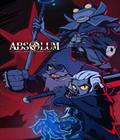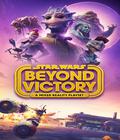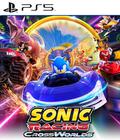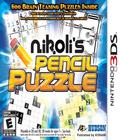The name Nikoli might not be recognizable in North America, but over the years, we've definitely experienced some of its content. In Japan, people know it because of a quarterly magazine. Full of all sorts of puzzles and brain-teasers, the magazine has had success in that country, and some of that has extended here because of the Sudoku craze. With that in mind, Hudson thought it would be a good idea to give the fledgling 3DS some puzzle action with Nikoli's Pencil Puzzle. While the game is quite good, there doesn't seem to be a reason that this game couldn't have be done on the regular Nintendo DS.
After you pick a save slot, the game lets you choose between one of four puzzle types. Sudoku is probably the most familiar and, for that reason, 300 puzzles of varying difficulty are included in this package. For the unfamiliar, you're presented with a nine-by-nine grid with each section split into three-by-three squares. Some of the tiles are already filled in with numbers, and it is your job to ensure that each three-by-three field contains the numbers one through nine. The catch is that the same number cannot exist in the same line either horizontally or vertically, so each three-by-three field along with each horizontal line and vertical line must contain a complete set of the numbers one through nine, without any repeats.
Shikaku is a game where you're given a tiled board and the task of filling it in with boxes. The catch is that each box must contain a number that corresponds to the size of the box. For example, if the box contains the number six, it can only contain six tiles in either a two-by-three configuration or a one-by-six configuration. To add to the confusion, no boxes can overlap, and no two numbers can exist in one box. There are 110 puzzles that not only vary in difficulty but also in size, as later puzzles occupy more than one screen.
Hashi is an interesting game using the concept of islands and bridges. You're once again given a board with some numbers on it. Each number represents an island and the number of bridges that must connect to that island. You can have up to two bridges connect the same two islands, but each bridge cannot cross over one another. Also, the system of bridges must ensure that all of the islands are interconnected in some way. Like the other games, there are 70 puzzles of varying difficulty.
Akari, the final game in the package, has you playing around with light bulbs as you try to illuminate every square tile on the board. The numbered squares indicate how many bulbs one can place around the filled-in tile, though you cannot place bulbs in squares that have already been lit by other bulbs. While you have to place bulbs around the numbered tiles, you aren't restricted to only placing bulbs around numbered tile areas, so you do have more freedom to experiment with proper bulb placement. There are 120 puzzles of this type.
Combining them gives you 600 individual puzzles to solve, something no portable game has really offered before. Interestingly, while the games are completely different experiences, they interact in one way. Solving each puzzle in any game and difficulty level gives you a hint coin that can be spent for a partial solution to a puzzle. The good thing is that the coins aren't restricted to a puzzle type, so if you're doing well at Sudoku but poorly at Akari, you can take the coins earned from Sudoku and spend it to get help at Akari. It is a great addition that ensures people will at least be able to get past the first puzzle in each game.
While the lower screen gets a majority of your attention, the upper screen does a few things, too. The upper screen can feature the entire board if you want; it's helpful for larger puzzles, but if you didn't want that, you have two other options. The first option is a random object that stays on the top without any movement or interaction. It feels useless to have, and one wonders who will choose this. The second visual option presents something that is affected by your puzzle actions and is vastly different per game type. Akari has a bubble-blowing boy who turns on lights in a mansion filled with hallways, sometimes uncovering a burglar in the process. Hashi features Bomberman building bridges on different islands as well as blowing up ones that are taken away. Shikaku presents three cars racing in a TRON-like environment. Finally, Sudoku features a slideshow of several different monuments pass by as your completed squares dance around the screen. Again, the screens are nice, though the Sudoku ones prove to be the least interesting, but since your attention will most likely go to the bottom screen for a majority of the time, you might not really notice this.
Puzzle games don't really need fancy graphics, but this one still tries to deliver something else to look at if you get tired of looking at the puzzle. The play field is quite plain, but the board is crystal clear so there's no mistaking what you're doing. As for the upper screen, it looks fine, but simpler seems to be better here. Objects don't carry that much detail, so the random stationary objects and renditions of monuments don't look as good as one would have hoped. Meanwhile, the simplicity of Bomberman and the islands makes it look spectacular by comparison. Still, the parts that matter look good enough, and that's all puzzle players really want.
Of all of the games released for the portable so far, this one doesn't seem to really need the 3-D effect. The animated cut scenes look nice on some of the puzzles, but once you see the animations repeat, you won't have any desire to see them enhanced. It is much better than seeing the random still objects in 3-D, however, but since you'll likely turn off the animated displays in favor or seeing the whole puzzle field, it feels like the inclusion of 3-D was there to justify the game's presence on the system. On that note, one has to wonder why they didn't just make the upper screen display the puzzle in 3-D just for kicks.
Like the graphics, the sound feels a bit antiquated. The music more closely resembles a MIDI tune than something more robust. Almost all of the music mimics classical pieces, so it feels right at home for a puzzle game, but you wish that the quality could have been improved somehow.
Nikoli's Pencil Puzzle is a fine game but seems to be an ill fit for the Nintendo 3DS platform. The 3-D effect is gimmicky at best, and with most of the images on the upper screen being either useless or not amusing, you won't care about them. Unless the amount of data was simply too large for normal carts, you have to wonder why this wasn't simply released for the regular Nintendo DS at a lower price. There isn't really anything like this title in terms of the sheer quantity of puzzles, and since the price is cheaper than most new 3DS games, it almost seems like a bargain. This game is a good choice if you're hungry for puzzles on the 3DS.
Score: 7.0/10
More articles about Nikoli's Pencil Puzzle











 Engage your mind with diverse and challenging puzzles. Take the game on the go, play on breaks, or relax at home. Offering a variety of games at several difficulties, Nikoli's Pencil Puzzle brings fan-favorite puzzles to your fingertips.
Engage your mind with diverse and challenging puzzles. Take the game on the go, play on breaks, or relax at home. Offering a variety of games at several difficulties, Nikoli's Pencil Puzzle brings fan-favorite puzzles to your fingertips.















